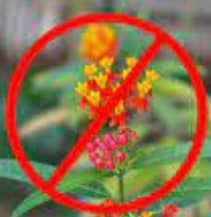The introduction of non-native species can have far-reaching ecological impacts that are often difficult to predict. In southern California, the planting of non-native or tropical milkweed (Asclepias curassavica) has become a common practice among gardeners and monarch butterfly enthusiasts. However, recent research has shown that this seemingly harmless act can have dangerous consequences for the monarch butterfly population and the broader ecosystem.
Unfortunately, the population of monarch butterflies has declined dramatically in recent years, and scientists believe that the planting of non-native or tropical milkweed in southern California may be partially to blame.
Tropical milkweed is native to Central and South America and is a popular choice among gardeners due to its bright orange and red flowers and its ability to attract monarch butterflies. However, unlike native milkweed species, tropical milkweed does not die back in the winter and can continue to produce new growth throughout the year. This extended growing season can lead to a buildup of parasites and disease that can be transmitted to monarch butterflies.
Researchers have found that monarch butterflies that feed on tropical milkweed are more likely to contract a debilitating parasite known as OE (Ophryocystis elektroscirrha). This parasite can reduce the lifespan of monarch butterflies and make them more susceptible to other diseases. In addition, the extended growing season of tropical milkweed can disrupt the natural migratory behavior of monarch butterflies. Monarchs that feed on tropical milkweed may delay their migration or stop migrating altogether, leading to a decline in the overall population.
The planting of non-native or tropical milkweed can also have broader ecological impacts on the southern California ecosystem. Milkweed is an important host plant for many other native species of butterflies and moths, and the planting of non-native milkweed can disrupt these natural relationships. In addition, tropical milkweed is known to compete with native plant species for resources, which can lead to a decline in biodiversity.
To address these issues, scientists and conservationists are encouraging the planting of native milkweed species in southern California. Native milkweed species, such as narrowleaf milkweed (Asclepias fascicularis) and showy milkweed (Asclepias speciosa), are better adapted to the local climate and are less likely to harbor parasites and diseases. In addition, planting native milkweed can help support the broader ecosystem by providing habitat for other native species of butterflies and moths.
Conservationists are also urging gardeners and monarch enthusiasts to practice responsible gardening techniques. This includes avoiding the use of pesticides and herbicides, which can harm monarch butterflies and other beneficial insects. It also means avoiding the overuse of non-native plants and focusing on creating diverse, native plant communities that support a variety of wildlife.
The planting of non-native or tropical milkweed in southern California may seem like a harmless act, but it can have dangerous consequences for the monarch butterfly population and the broader ecosystem. By choosing to plant native milkweed species and practicing responsible gardening techniques, we can help support the survival of this iconic species and promote a healthier, more sustainable ecosystem.


